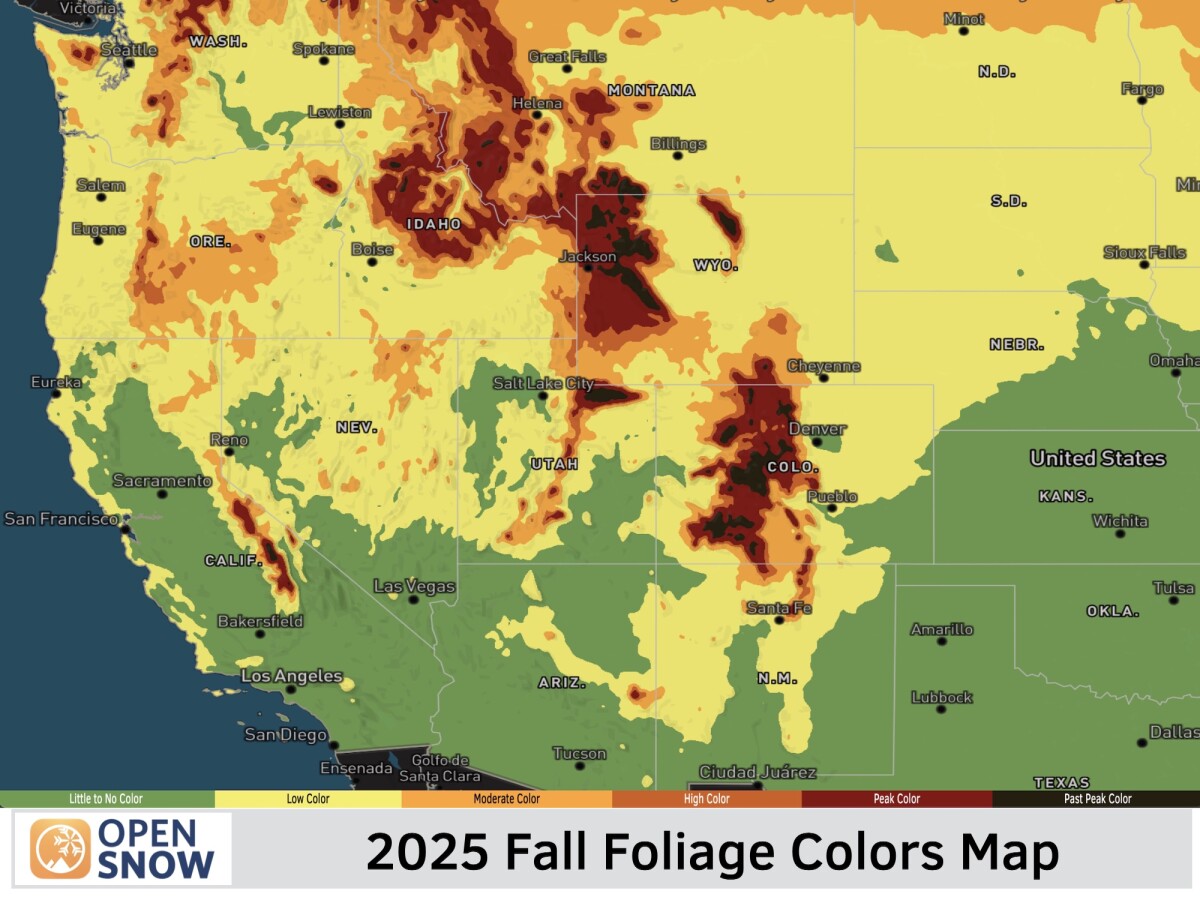News

By Sam Collentine, Meteorologist Posted 6 years ago February 9, 2019
Insider's Guide to Skiing Snowbird, Utah
The following guide was written by Utah Forecaster Evan Thayer and sponsored in partnership with our friends at Snowbird.

When you think of iconic, bucket list ski destinations, Snowbird should be right at the top of everybody’s list. Near the top of Utah’s beautiful Little Cottonwood Canyon, this mountain has been a big part of my life for as long as I can remember.
Snowbird is largely responsible for why I have spent most of my adult life living in Utah. It is the place to ski or snowboard in Utah if you are looking for the ultimate winter adventure experience.
RESORT OVERVIEW
Snowbird offers 2,500 acres of skiable terrain, accessed by 11 lifts and 85 trails. The mountain stretches from a base elevation of 7,760 feet to a summit elevation of 11,000 feet.

Our friends at Zrankings list Snowbird's True Annual Snowfall at 497 inches. 27% of the mountain is considered easy terrain, 35% difficult, and 38% intermediate terrain. 13% of the mountain features a south-facing aspect, 16% east-facing, 21% west-facing, and 50% north-facing.
The lift operating hours run from 9:00 am - 4:00 pm (weather and lift depending).
MY HISTORY WITH SNOWBIRD
My relationship with Snowbird began before I was even born. My parents married and moved to Lake Tahoe in 1976. Summers around Tahoe were incredible and, in winter, the skiing was great. However, my parents found that every spring, once the snow in Tahoe was winding down, they could travel east to Utah and still find high-quality powder well into April.
This realization led to them purchasing a timeshare condominium each year at the famed Iron Blosam Lodge at the base of Snowbird. From then on, my family would spend a week each spring exploring the mountain and skiing Utah powder.

Evan's father at the Mid-Gad Lodge, Snowbird, UT, circa the late 1970s.

Evan's mother enjoying Gad Valley above the Iron Blosam Lodge at Snowbird, UT, circa the late 1970s.
As my Dad says now, still smiling, "We went there for years and there wasn’t a single trip that we didn’t get a good storm at some point during the week." My father’s stories were told to me many times as I grew up learning to ski around Lake Tahoe.
To me, Snowbird sounded like a mythical place where it always snowed and the powder was up to your waist. These stories were so powerful, in fact, that when my wife was offered a job in Utah many years ago, I didn’t think twice – we packed up and moved. One of the first things I did when I arrived in Utah was to buy a Snowbird Season Pass and I’ve been skiing there ever since.
GETTING TO SNOWBIRD
Snowbird is only a 45-minute drive from the Salt Lake City International Airport. You can literally fly into SLC in the morning and be riding powder in the afternoon.
Driving Directions: Snowbird
Snowbird also has some of the best on-mountain lodging accommodations in the state. The Cliff Lodge is right next to the base of the tram. It offers some of the best views of Snowbird and Little Cottonwood Canyon. My favorite part of the Cliff Lodge is the rooftop pool and jacuzzi.

It's an incredible feeling to soak up there, surrounded by snow-caked peaks. You have a great view of much of the mountain. You can warm-up in the hot tub with your friends and actually point out the lines you skied earlier in the day.
Snowbird also has a host of dining options which you can find on their website. Personally, I love grabbing après drinks at the Tram Club – it’s an unforgettable setting down below the base of the tram where you have a full view of all the tram machinery hard at work carrying skiers up to Hidden Peak.
My other favorite dining location is the brand new Summit Lodge at the top of the tram. The Summit has beautiful floor-to-ceiling windows that allow you to fully experience Hidden Peak’s views.

The food is also some of the best I’ve had. Whether it’s lunch during your ski day or a romantic dinner at sunset, I highly recommend a visit to The Summit.
SNOWBIRD SNOW & WEATHER
First and foremost, the snow.
Snow is what sets Snowbird apart from the rest. The quantity of snow is absolutely astounding at 497 inches/season (ZRankings). The snowfall is also very evenly distributed throughout the ski season. The months of December through March average about 90 inches of snowfall per month. November and April each average about 60 inches. This helps Snowbird to have "the longest season in Utah.” It also gives its visitors one of the highest probabilities of skiing powder of any resort in North America.
Snowbird also boasts some of the highest snow quality on the continent. The average water content of the snow is only about 7-8%, and Snowbird frequently sees storms that finish cold with the top layers of snow having water content below 5%. This means that Snowbird has some of the fluffiest powder around. It’s no wonder so many covers of ski magazines have been shot at Snowbird.
Overall, Snowbird’s "Snow Score" (ZRankings) puts it as the #2 resort for snowfall in North America, trailing only Snowbird’s neighbor Alta. If you ask me, it’s safe to call it a tie for the #1 spot.
All of this snow isn’t going to waste either – rather, it is falling on some of the best terrain in the world. Snowbird offers more than 3,000 vertical feet over 2,500 acres of some of the most diverse terrain in the world. Starting at 8,000 feet and rising to Hidden Peak at 11,000 feet, the Aerial Tram takes you to the top.

Almost all of Snowbird’s terrain can be accessed from the Tram, and the views from the Hidden Peak are jaw-dropping. Even Snowbird’s mountain cams are mind-bogglingly beautiful.

The views from Hidden Peak stretch south to the backside of Mount Timpanogos, north to the imposing south face of Mount Superior, and west down Little Cottonwood Canyon to the Salt Lake Valley and the Great Salt Lake beyond.
Snow Forecast & Report: Snowbird, Utah
SKIING & RIDING SNOWBIRD
Once you’re done taking in the sights, it’s time to start exploring the mountain. One of my favorite things about Snowbird is that it has everything, which means it will suit everybody’s skiing/riding styles, moods, or weather conditions. There’s always something new and fun to try at 'the Bird'. When many people hear Snowbird mentioned, they immediately think of the steep, gnarly terrain that drops off "The Cirque."
The Cirque is the ridgeline that divides Gad Valley and Peruvian Gulch. Along with cliff lines that will challenge even the best skiers/riders (Snowbird frequently hosts stops on the Freeride World Tour), the Cirque also offers some wide open bowls as well as epic tree skiing off the nose of the ridge. Some of the best powder runs of my life have come from venturing out onto the Cirque.
However, if it’s a storm day and you’re looking for some trees to get your bearings, Snowbird also offers that in spades. My favorite area for tree skiing is the Gad II Lift, which was upgraded to a high-speed quad a few years back. This lift accesses several tree areas, including Tiger Tail trees. No place better to be on a storm day than in the Tiger Tail.

Finally, Snowbird offers something that no other resort in Utah can claim – a high alpine, south-facing bowl – Mineral Basin.
Mineral Basin can be accessed from the top of the tram, from the top of Little Cloud chair, or from the top of Peruvian Express via the one-of-a-kind Snowbird Tunnel. Mineral Basin is indescribable on a bluebird powder day. There may be no better feeling than when the rope drops at the top of Mineral Basin after a big storm and you have 2,000 vertical feet of completely uninterrupted powder ahead of you.

Mineral Basin is also one of my favorite places to hike in the summer for wildflowers.

From steeps and chutes to tree skiing to big open powder bowls to immaculate groomers, Snowbird really does offer everything. Geographically, it is the perfect location for nearly 500 inches of snow to fall each winter.
FINAL THOUGHTS
Snowbird has been a huge part of my life for a long time. Because of this, it holds a special place in my heart. As the Utah Forecaster for OpenSnow, Snowbird is an absolute dream because it feels like it’s always snowing there. Seldom do we at OpenSnow have a forecast during the winter that doesn’t have an incoming storm. When the storms do arrive, they seem to overproduce at Snowbird far more than anywhere else.
As University of Utah Atmospheric Sciences professor, Jim Steenburgh, says, "In Little Cottonwood Canyon, you don’t need a reason for it to snow, you need a reason for it to stop snowing." To me, this quote sums it up perfectly. Snowbird has it all, but above all else, it has snow – the best snow on the entire continent.
Visit Snowbird.com for all lodging, event, and other ski-related information.
OPENSNOW RESOURCES
Snow Forecast & Report: Snowbird, Utah
Daily Snow Forecast: Utah
Download: OpenSnow Mobile App
This guide was sponsored in partnership with our friends at Snowbird.
About The Author




